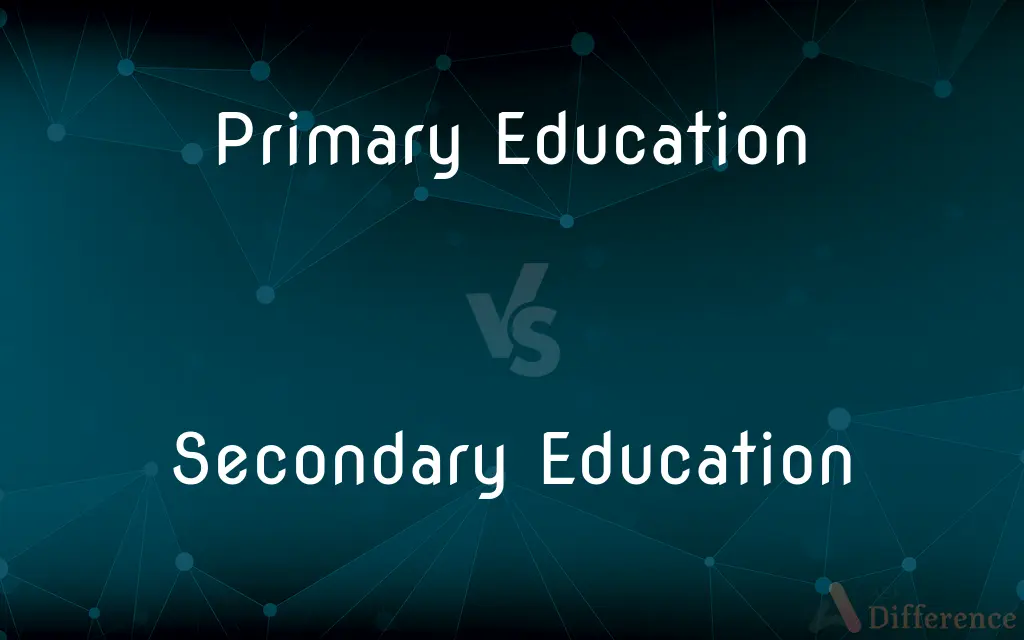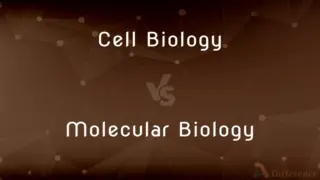Primary Education vs. Secondary Education — What's the Difference?
By Tayyaba Rehman — Published on November 7, 2023
Primary Education typically covers foundational skills and basic knowledge for young children, while Secondary Education focuses on deeper academic subjects and preparation for higher education or work.

Difference Between Primary Education and Secondary Education
Table of Contents
ADVERTISEMENT
Key Differences
Primary Education and Secondary Education are distinct stages in a person's academic journey, each serving a unique purpose. They're foundational to most educational systems worldwide.
Primary Education, often referred to as elementary education, begins at a young age and lays the groundwork for a child's academic path. It emphasizes fundamental skills like reading, writing, and arithmetic. The purpose of Primary Education is to ensure that students acquire the basic tools they'll need to further their education.
On the other hand, Secondary Education usually starts after the completion of primary schooling. This phase delves into more specific academic subjects such as sciences, humanities, arts, and more. Secondary Education prepares students for more advanced studies, vocational training, or entry into the workforce.
It's important to understand that while Primary Education gives students the basics, Secondary Education helps them specialize and decide the direction of their future careers or studies. Both stages are integral, building upon one another to provide a comprehensive education.
Comparison Chart
Aim
Instill basic skills and foundational knowledge.
Delve deeper into academic subjects and prepare for higher education/work.
ADVERTISEMENT
Typical Age Group
Young children (e.g., 5-11 years old).
Adolescents to young adults (e.g., 12-18 years old).
Depth of Subjects
Introductory and foundational.
Advanced and specialized.
Duration
Typically lasts for 6 years.
Varies, but typically lasts for 6-7 years.
Transition
Introduction to schooling.
Transition to higher education or the workforce.
Compare with Definitions
Primary Education
Introduction to basic academic skills.
Primary Education emphasizes reading, writing, and arithmetic.
Secondary Education
Advanced academic phase with specialized subjects.
In Secondary Education, students often choose electives based on their interests or career goals.
Primary Education
The first stage in formal schooling.
After preschool, children enter Primary Education to begin their academic journey.
Secondary Education
The step before tertiary education or the workforce.
Secondary Education concludes with diplomas or certificates that aid in college admissions or job applications.
Primary Education
Essential foundation for further studies.
Without a strong Primary Education, students might struggle in subsequent academic stages.
Secondary Education
Schooling that follows primary education.
After finishing elementary school, students move to Secondary Education, often referred to as high school.
Primary Education
Foundational schooling for young children.
In the U.S., Primary Education typically covers kindergarten through fifth grade.
Secondary Education
Prepares students for higher education or employment.
Secondary Education includes subjects that equip students for college or jobs.
Primary Education
Focused on general knowledge and basic skills.
Subjects in Primary Education provide a broad overview of many topics.
Secondary Education
Schooling that goes deeper into academic disciplines.
Topics in Secondary Education provide in-depth knowledge, from calculus to literature analysis.
Common Curiosities
What's the main outcome of Secondary Education?
Secondary Education prepares students for higher studies, vocational training, or the workforce.
Are middle schools part of Primary or Secondary Education?
In many systems, middle schools are the initial part of Secondary Education.
At what age does Secondary Education typically start?
Secondary Education usually starts after primary schooling, around age 12.
Are high schools and colleges both part of Secondary Education?
High schools fall under Secondary Education, while colleges are part of tertiary education.
What is the main goal of Primary Education?
Primary Education aims to instill basic skills and foundational knowledge in students.
How does the depth of subjects compare between the two?
Primary Education provides a foundational overview, while Secondary Education dives deeper into subjects.
How long does Primary Education usually last?
Primary Education typically lasts around six years, but it can vary by country.
Does Primary Education cover specialized subjects?
No, Primary Education focuses on general knowledge and foundational skills.
Is Primary Education compulsory in most countries?
Yes, in many countries, Primary Education is mandatory.
What's the significance of diplomas in Secondary Education?
Diplomas from Secondary Education can aid in college admissions or job applications.
Share Your Discovery

Previous Comparison
Lactate vs. Lactic Acid
Next Comparison
Cell Biology vs. Molecular BiologyAuthor Spotlight
Written by
Tayyaba RehmanTayyaba Rehman is a distinguished writer, currently serving as a primary contributor to askdifference.com. As a researcher in semantics and etymology, Tayyaba's passion for the complexity of languages and their distinctions has found a perfect home on the platform. Tayyaba delves into the intricacies of language, distinguishing between commonly confused words and phrases, thereby providing clarity for readers worldwide.












































